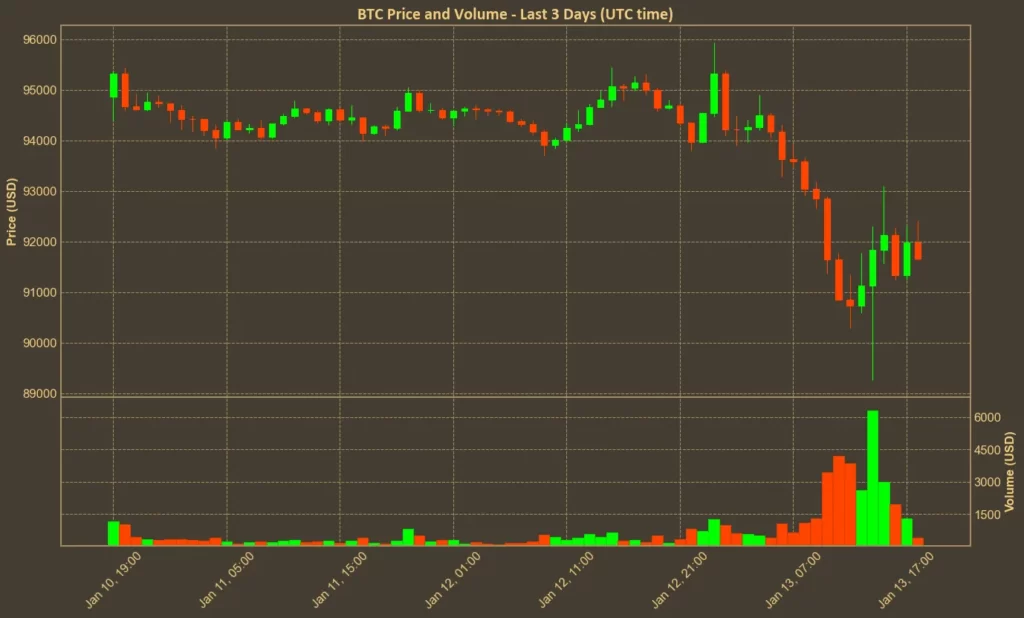In this article:
- Crypto markets are down today, with Bitcoin around $92k and Ethereum near $3000
- Concerns about higher U.S. interest rates are a key factor behind the drop.
- Additional pressure comes from rising bond yields and a strengthening dollar.

Another correction occured today, and while Bitcoin continues to hold its position for now, the recent trends suggest a mixed outlook for investors. Currently Bitcoin trades near $92,000 – a drop 3% from yesterday – but at one moment today it slipped briefly $90,000. Other cryptocurrencies are also not having a great day – Ethereum fell 8% today and barely holds to $3,000 level, and other major altcoins are all in red today.
Table of Contents
Macroeconomic Pressures
Bitcoin’s current is mainly caused by the broader economic landscape. The U.S. job market remains robust, with over 250,000 jobs added last month, far exceeding expectations. While a strong job market is generally positive, it also contributes to inflationary pressures, prompting the Federal Reserve to maintain higher interest rates. This decision has a direct impact on risk assets like Bitcoin, as higher interest rates make traditional investments more attractive compared to volatile cryptocurrencies.
Rising bond yields have further strained Bitcoin’s performance. The 10-year U.S. Treasury yield has reached its highest level since October 2023, adding another challenge for the cryptocurrency. Additionally, the U.S. Dollar Index has surged past 110, strengthening the dollar and putting additional pressure on Bitcoin’s price. A stronger dollar typically means that riskier investments, including cryptocurrencies, become less appealing to investors.
Investors Are Waiting
Many indicators show that the cryptocurrency market is experiencing a noticeable slowdown recently. Inflows have dropped, and trading activity has hit lows not seen since before last year’s U.S. elections. This decline indicates a growing hesitation among investors. While Bitcoin’s market capitalization still stands strong at a $1.83 trillion, the drop in volume change over the past month signals that investors are becoming more cautious.
The decline in trading activity, hitting pre-election lows, reflects a broader sense of uncertainty. Investors seem to be waiting for clearer signals before making significant moves. One indicator of this caution is the rise in stablecoin reserves, now totaling $48 billion USDT equivalent. This surge suggests that a substantial amount of capital remains on the sidelines, waiting for the right moment to re-enter the market.
Not everyone is waiting though. MicroStrategy’s has purchased an additional 2,530 BTC, bringing its total holdings to 450,000 BTC. This aggressive strategy shows a belief in Bitcoin’s long-term value, even as market conditions remain volatile. While critics argue that such large-scale purchases are risky, proponents believe that holding substantial Bitcoin reserves can yield significant returns as the market stabilizes and grows.
What’s Next?
Despite the current slowdown, there is still optimism within the Bitcoin community. Historical patterns suggest that periods of fear and low trading volume often precede significant rebounds. The substantial stablecoin reserves could provide the necessary liquidity to fuel a recovery once market sentiment turns positive. However, the risk of prolonged stagnation remains if investor confidence does not return.
The Federal Reserve’s next moves will be important in shaping Bitcoin’s trajectory. With the upcoming inflation data release, market participants are awaiting any indications of changes in monetary policy. Should the Fed decide to maintain higher interest rates to combat inflation, Bitcoin may continue to face downward pressure. However, any signs of easing could revive the market, leading to increased investment and potentially driving prices higher.
It’s also important to remember that Donald Trump’s inauguration will take place one week from now. If he begins implementing his pro-crypto policies, the FED strategy might shift to a secondary role. We have described his promises in this article.




